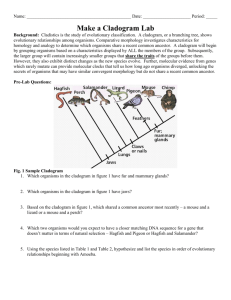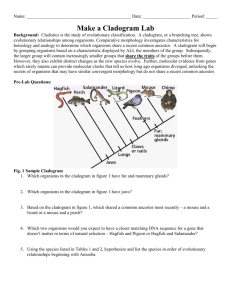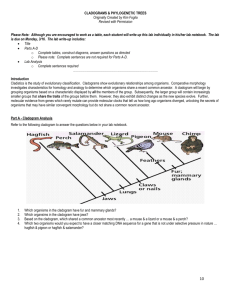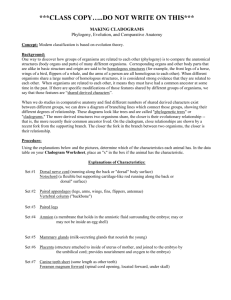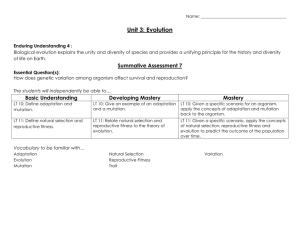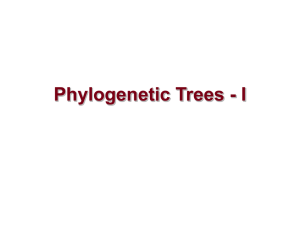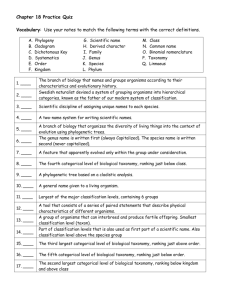Cladograms & Phylogeny: Evolutionary Relationships Worksheet
advertisement
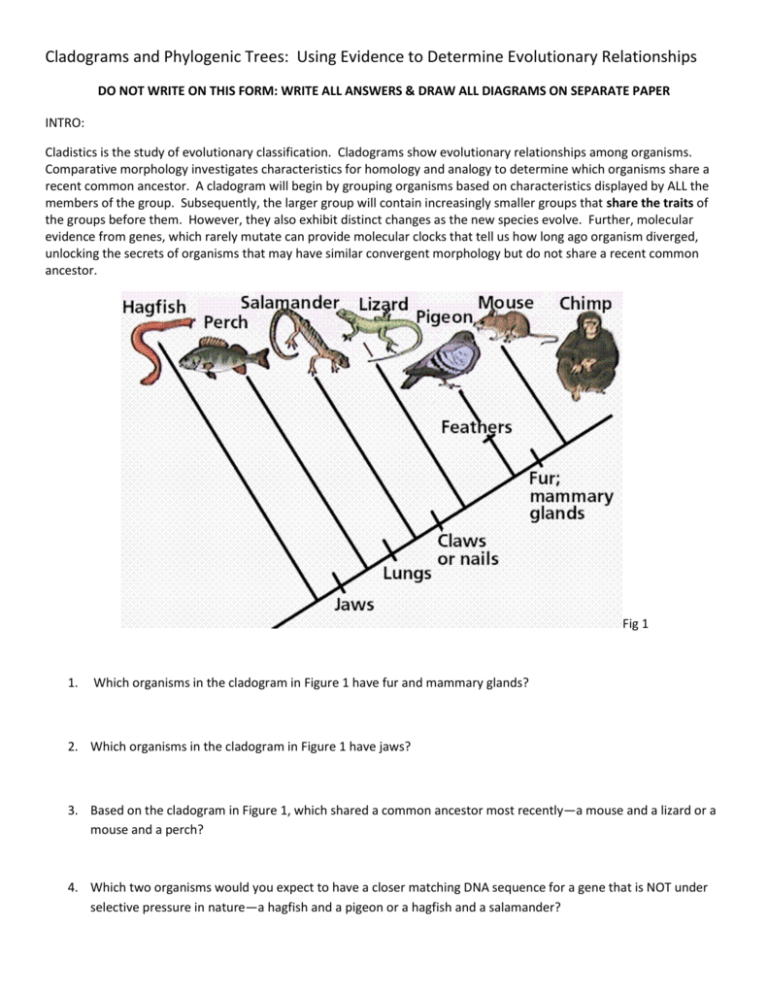
Cladograms and Phylogenic Trees: Using Evidence to Determine Evolutionary Relationships DO NOT WRITE ON THIS FORM: WRITE ALL ANSWERS & DRAW ALL DIAGRAMS ON SEPARATE PAPER INTRO: Cladistics is the study of evolutionary classification. Cladograms show evolutionary relationships among organisms. Comparative morphology investigates characteristics for homology and analogy to determine which organisms share a recent common ancestor. A cladogram will begin by grouping organisms based on characteristics displayed by ALL the members of the group. Subsequently, the larger group will contain increasingly smaller groups that share the traits of the groups before them. However, they also exhibit distinct changes as the new species evolve. Further, molecular evidence from genes, which rarely mutate can provide molecular clocks that tell us how long ago organism diverged, unlocking the secrets of organisms that may have similar convergent morphology but do not share a recent common ancestor. Fig 1 1. Which organisms in the cladogram in Figure 1 have fur and mammary glands? 2. Which organisms in the cladogram in Figure 1 have jaws? 3. Based on the cladogram in Figure 1, which shared a common ancestor most recently—a mouse and a lizard or a mouse and a perch? 4. Which two organisms would you expect to have a closer matching DNA sequence for a gene that is NOT under selective pressure in nature—a hagfish and a pigeon or a hagfish and a salamander? Part I: Morphological Evidence: Using your text and prior knowledge (what you already know), determine the morphological characteristics of the organisms in the following table. For every characteristic the organism possesses, put a checkmark in that box. Organism Eukaryote Multicellular Segmented Jaws Body Limbs Hair Placenta Common Ancestor Amoeba Kangaroo Earthworm Cat Shark Dolphin Lizard Sponge Has Bone # of differences from Ancestor N/A Given the data you have compared, draw a cladogram based on these morphological characterisitics. Part II: Molecular Evidence: Cytochrome c is a protein located in the mitochondria of cells involved with cellular respiration. Compare each organism’s cytochrome c DNA sequences with the ancestor cell and each other. Circle or highlight the differences (mutations) present in the cytochrome c DNA sequences from the Ancestor cell. Cytochrome c DNA Sequence Data: Organism DNA Sequence Ancestor Earthworm ATTAGCGACCAGTATATCCTACAATCCGTCTACTTCATT ATTAGCGACCAGTTTATCCTACAATCCCGTCTACTTCAT CTAATCCCCCCGTTTATCCTACTTTCCCATCTACTAAGT CTTATCGACCCGTTTATCCTACATTCCCGTCTACTTCGT Cat TTAATCCCCCCGTTTATCCTACTTTCCCATCTACTAAGT Shark CTTATCCCCCCGTTTATCCTACTTTCCCGTCTACTTCGT Dolphin CTAATCCCCCCGTTTATCCTACTTTCCCATGTAGTAAGT Lizard CTAATCCCCCCGTTTATCCTACTTTCCCGTCTACTTCGT Sponge ATTATCGACCAGTTTATCCTACATTCCCGTCTACTTCGT Amoeba Kangaroo Using the above data: create a cladogram based on molecular evidence. Comparing Part I and Part II: 1. How did your morphological cladogram compare with your cladogram based on the cytochrome c DNA evidence? 2. Compare and contrast convergent evolution with divergent evolution. Which two organisms show convergent evolution in the cladogram from part II? Why might these two organisms have similar morphology despite not sharing a recent ancestor? 3. Which type of evidence is most accurate in determining evolutionary relationships? Morphology or molecular? Why? Part III: A phylogenetic tree is a tree showing the evolutionary interrelationships among various species that are believed to have a common ancestor. A phylogenetic tree is a form of a cladogram. In a phylogenetic tree, each node with decendants represents the most recent common ancestor of the descendents, and edge lengths correspond to time estimates. An example of a phylogenetic tree is below. Phylogenetic trees requires each species to be compared to each other as in the following chart. Organism Horse Donkey Whale Chicken Penguin Snake Moth Yeast Wheat Horse 0 Donkey 1 0 Whale 5 4 0 Chicken 11 10 9 0 Penguin 13 2 10 3 0 Snake 21 20 18 18 17 0 Moth 29 28 27 29 27 29 0 Yeast 45 46 45 46 45 46 48 0 Wheat 46 45 44 46 46 46 45 47 0 As a class lets demonstrate this process. Use the data from the chart above to complete the cladogram outline below: Now you will make a phylogenetic tree for the different species you’ve studied in reference to the differences in their Cytochrome c proteins (Part II DNA comparison). In order to do this you will not only have to compare the DNA sequences to the ancestor DNA but to each other’s DNA. Use a chart like below to record the number of differences between each pair compared. Use the data you collect to create a phylogenetic tree (cladogram) Organism Common Ancestor Amoeba Kangaroo Earthworm Cat Shark Dolphin Lizard Sponge Common Ancestor 0 Amoeba Kangaroo Earthworm Cat Shark Dolphin Lizard Draw out your phylogenetic tree. 1. How does it compare to the first two cladograms you created? a. How is it similar? b. How is it different? c. Which provides more information/detail? d. How accurate do you believe this process to be? Where might the inaccuracies occur? Sponge 0

